Where to dig in?
What is no till gardening?
Implementing no-till gardening helps you preserve soil structure by preventing compaction, maintain underground networks of earthworms and microbes, and improve water infiltration to reduce erosion. You can enhance soil health with techniques like applying compost and mulch, and using cover crops. No-till methods also offer economic benefits, such as reducing fuel consumption and labor costs. As you continue, you’ll discover more about how no-till boosts crop yields and supports ecological balance.
Soil Health Benefits
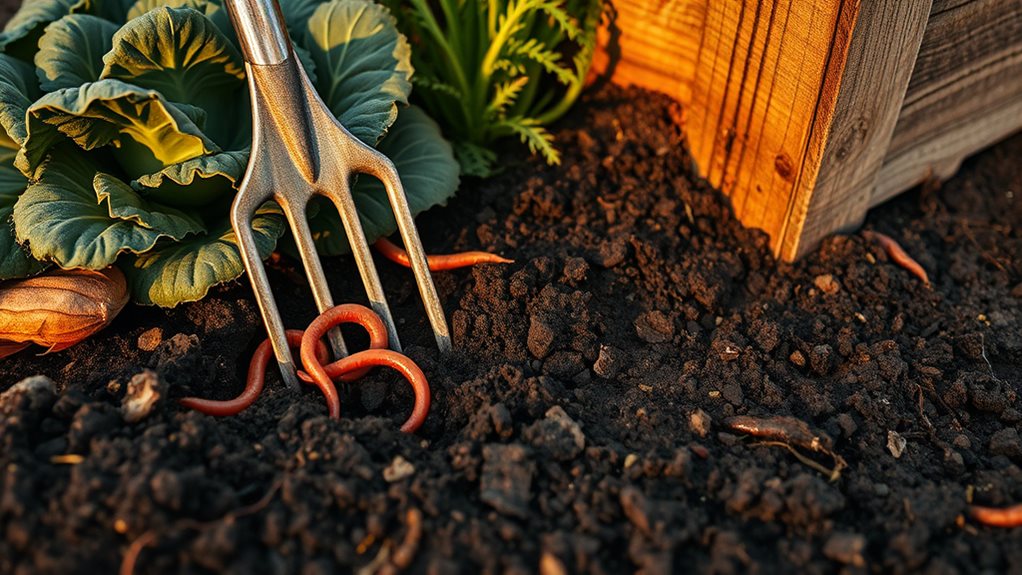
No-till gardening preserves soil structure by preventing compaction that usually happens with traditional tilling, which breaks the soil into tiny particles that settle and harden. This method keeps underground networks of earthworms and microbes intact, improving aeration and nutrient flow.
When you don’t till, your soil holds more air pockets and becomes more porous, allowing water and nutrients to move efficiently to roots. You’ll notice better water infiltration, which reduces runoff and erosion. Additionally, loamy soil is often ideal for no-till gardening because its balanced composition enhances drainage and moisture retention, supporting diverse plant growth. Also, no-till promotes a richer soil microbiome with diverse bacteria and fungi that break down organic matter, enhancing nutrient cycling and soil health.
Additionally, no-till gardening helps to suppress weed growth by leaving weed seeds undisturbed, which reduces competition for water and nutrients. This leads to a more balanced ecosystem with fewer weeds, resulting in less need for manual weeding or herbicides, supporting overall garden health and reducing the need for weeding.
Over time, these improvements lead to healthier plants and more fertile soil, requiring fewer synthetic fertilizers, making your garden more sustainable.
Environmental Advantages
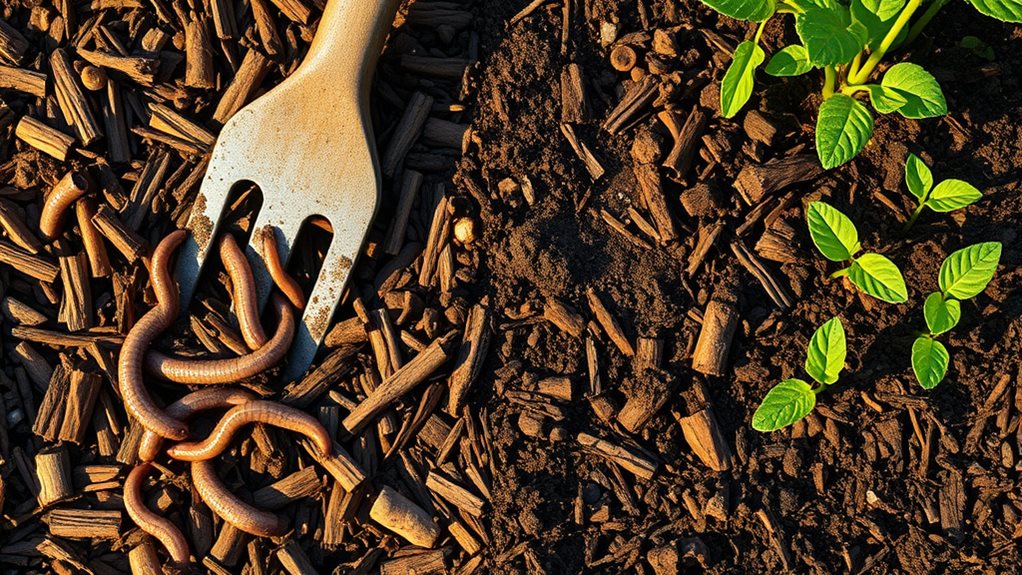
As you see the soil health benefits of no-till gardening firsthand, it’s clear that this method extends its advantages far beyond just soil health. No-till gardening reduces soil erosion by protecting topsoil from wind and water, which keeps nutrients where plants need them. It also locks carbon in the soil, helping fight climate change by lowering greenhouse gas emissions.
This approach retains moisture better, so you water less often, and preserves essential microorganisms that keep the ecosystem balanced. It can be advantageous to add brown materials such as cardboard to maintain a balanced carbon to nitrogen ratio within the soil. You’ll notice fewer pests and diseases too, thanks to improved biodiversity and natural pest control.
Additionally, no-till gardening saves labor and time while reducing chemical use and dependence on machinery, making it a sustainable, eco-friendly method supporting soil, water, and climate resilience all at once. By minimizing soil disruption, no-till preserves soil structure that is often destroyed by conventional tilling practices.
Economic Benefits
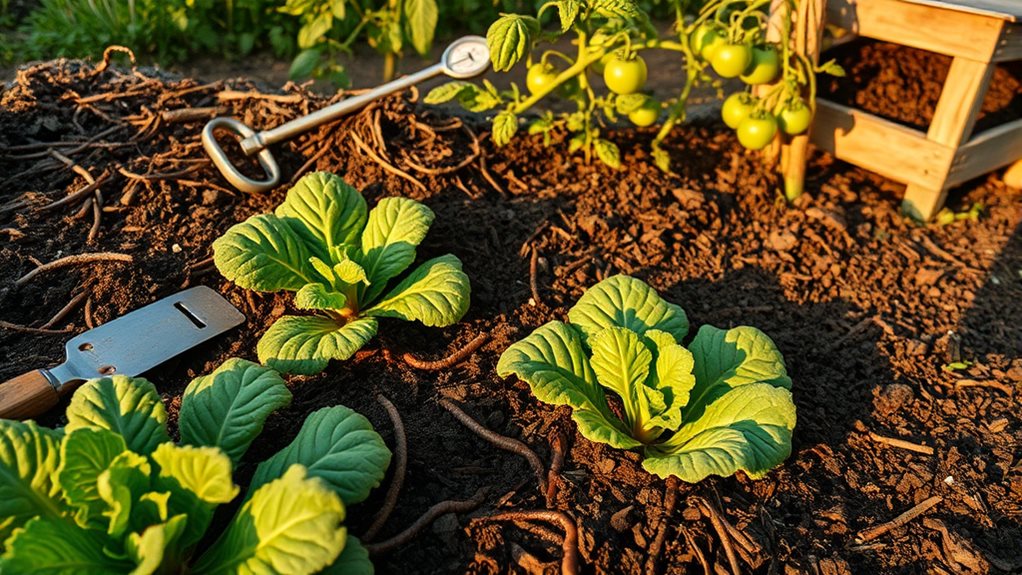
When you adopt no-till farming practices, you can expect substantial economic benefits that help bolster your financial stability. This method reduces fuel consumption and labor costs, which are essential for cost savings. You save approximately $6,600 on fuel per 1,000 acres annually, and labor time decreases remarkably.
Additionally, no-till farming can increase land value, particularly in the Midwest, where a 1% increase in no-till adoption leads to a significant rise in land value, with a 1% increase translating to a notable monetary benefit. Similar to how choosing the right fertilizer for a lawn can enhance its health, understanding the specific needs of your farm can maximize the benefits of no-till practices.
Economic Advantages of No-Till Farming
| Benefit | Description | Impact |
|---|---|---|
| Fuel Savings | Less fuel used for tillage | $6,600 per 1,000 acres |
| Labor Efficiency | Reduced labor hours per acre | Thousands in labor cost savings |
| Land Value Increase | No-till boosts land value, especially in Midwest | Increased property value and selling price |
Methods and Techniques
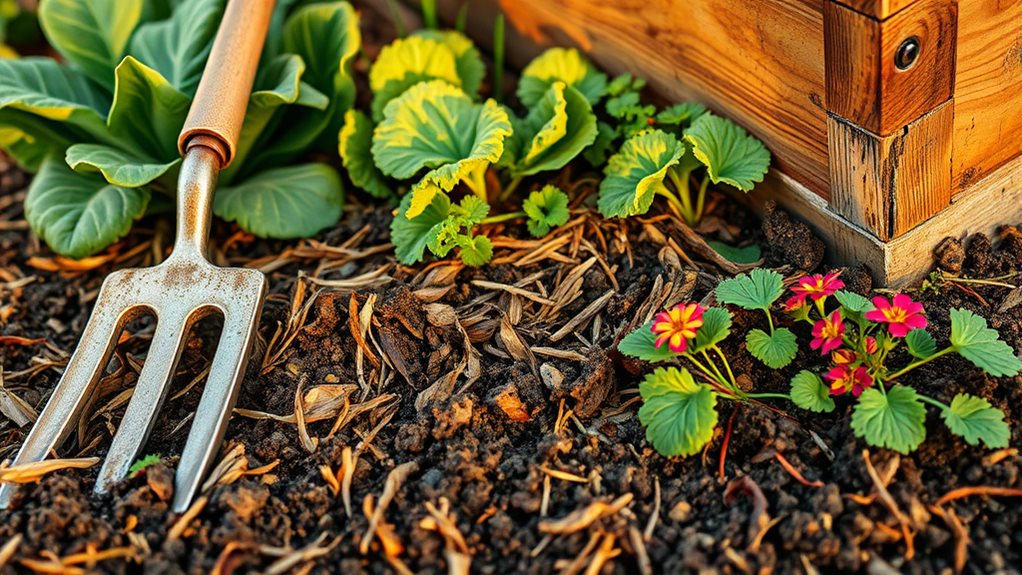
By focusing on reducing soil disturbance, you can markedly improve the health and fertility of your soil. Begin your no-till garden by laying down a cardboard layer to block weeds and prevent seed germination. Choosing the correct location is important, so aim for maximum sun exposure, especially in spring, to help your plants thrive in early growth stages garden placement. When planning your garden, ensure you select beginner-friendly vegetables that are well-suited to your local climate for the best chance of success. Next, apply about 3-4 inches of compost, which enriches the soil and improves its structure.
Then, add a thick mulch layer, such as woodchips or straw, to retain moisture and suppress remaining weeds. Water regularly to help decompose the organic materials and saturate the soil. Manage cover crops to enhance soil nutrients and prevent weeds.
Seasonal adjustments involve adding or thinning mulch layers as needed. Keep your beds around 4 feet wide for easy maintenance and minimal soil compaction. Use minimal-disturbance tools like shovels and rakes to preserve soil structure. This approach fosters healthy soil life and sustainable growth.
Crop Yields and Resilience
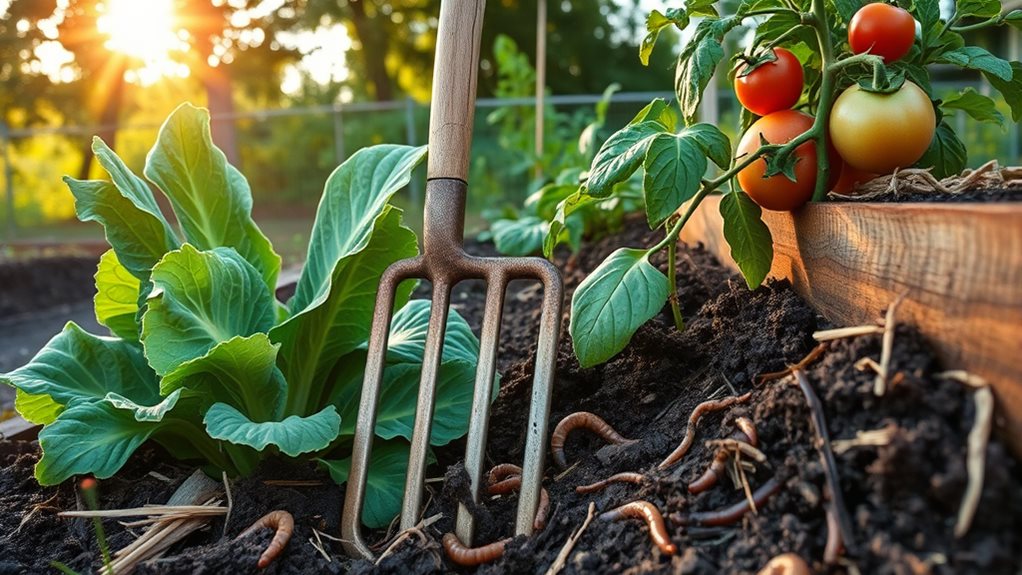
No-till gardening is a method that considerably enhances crop yields and resilience over time. It preserves soil moisture, which helps plants survive droughts, while the organic matter builds soil health. A key factor in successful decomposition is ensuring the right balance of nitrogen-rich “greens” and carbon-rich “browns,” which helps optimize soil health over time. Soybeans thrive with no-till, often showing higher yields, while corn may initially lag but improves long-term.
Crop rotation works well in no-till systems to maximize benefits and sustain the soil. Besides boosting yields, no-till reduces erosion and promotes biodiversity, increasing the land’s value. Economically, you save on labor, fuel, and equipment, making your farm more profitable. The consistent increase in crop yields over decades can be attributed to improvements in soil organic matter, including enhanced moisture retention that supports plant growth during adverse conditions.
| Crop | Average Yield (bushels/acre) | No-Till Yield Notes |
|---|---|---|
| Soybeans | 59.8 | Consistently high yields |
| Corn | 187.6 | Slightly lower short-term |
| Advantages | Economic, environmental | Moisture retention, less erosion |
Use no-till to improve both crop stability and long-term farm value.
Ecological Balance
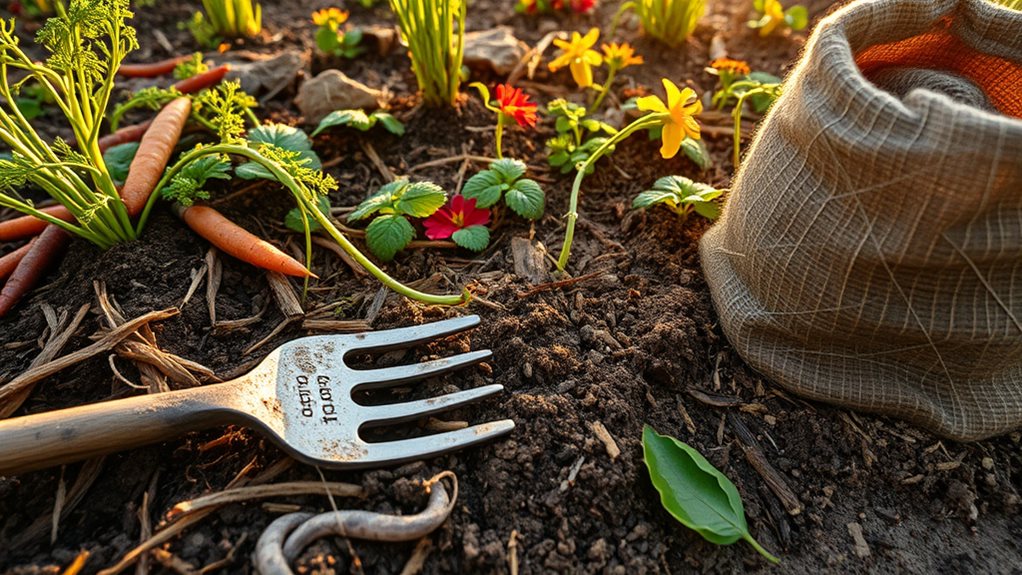
As you focus on improving crop yields and resilience, it’s also important to contemplate how no-till gardening contributes to ecological balance. This method preserves soil structure by minimizing disturbance, allowing air and water to circulate naturally. It supports microbial health by fostering diverse soil microorganisms that improve nutrient cycling and disease resistance. No-till also reduces soil erosion considerably, preventing nutrient loss and pollution in waterways. This is in contrast to soil-free hydroponics(Hydroponics) gardening, which uses nutrient-rich water for faster growth and higher yields.
- Water Conservation: No-till increases soil water retention, enhancing drought resilience and reducing irrigation needs.
- Carbon Sequestration: By keeping soil intact, it stores more carbon, helping mitigate climate change.
- Biodiversity Support: The practice preserves habitats for beneficial insects and microorganisms, which sustain ecosystem services and wildlife.
Embracing no-till gardening strengthens your garden’s ecological foundation while aiding environmental health.
Implementing No-Till Gardening
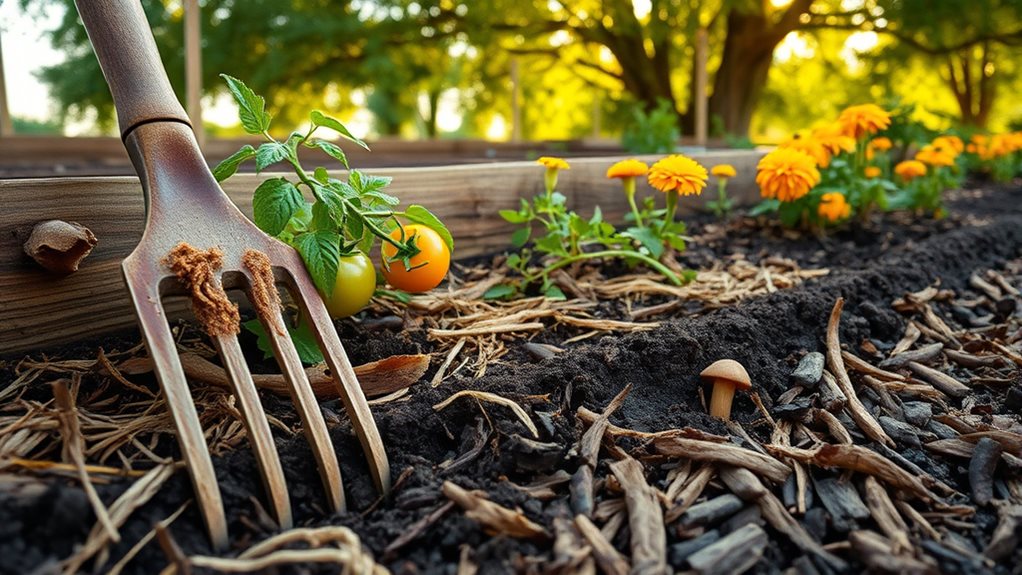
When you’re ready to move to no-till gardening, it’s crucial to start with a well-prepared garden bed. Avoid digging by clearing vegetation at ground level, preserving roots and organic matter. Apply thick layers of organic mulch like straw or compost to suppress weeds and enhance soil life. To promote a balanced growing environment that minimizes water and nutrient loss, consider incorporating biochar into your garden bed, as it effectively retains both moisture and nutrients.
To maintain soil health, use “chop and drop” methods for recycling nutrients, and avoid walking on beds to prevent compaction. Test soil regularly and amend as needed.
In seasonal care, gently remove winter mulch, add compost, and maintain mulch thickness during summer. Use cover crops in fall to protect soil and enhance microbial activity. Implementing no-till practices can help reduce soil erosion by preserving a protective layer of organic residue, which shields the soil from water runoff and maintains its structure.
Frequently Asked Questions
What Tools Are Needed for No-Till Gardening?
To start no-till gardening, you’ll need several key tools.
For soil preparation, use a roller/crimper to terminate cover crops and a flail mower for residue management.
For planting, precision planters and air drills are essential for precise seed placement.
For weed control, consider a flame weeder or hand tools like hoes and weeding forks.
Maintenance tools include wheelbarrows and shovels for handling materials without compacting the soil.
How Quickly Does No-Till Improve Soil?
You’ll see some immediate soil benefits with no-till gardening, like reduced compaction and initial weed suppression when you add mulch and organic matter.
Over 6 to 12 months, the organic layers break down, improving soil fertility, water retention, and biodiversity.
After 1 to 3 years, expect stronger microbial activity, better drainage, fewer weeds, and higher crop yields.
Stick with it consistently, and your soil health will keep improving year after year.
Is No-Till Suitable for All Crops?
You’ll find that no-till farming is suitable for many crops, like corn, soybeans, and wheat. However, it may not be ideal for all types of crops.
No-till works well in rotations, enhancing soil health, and is beneficial in regions with adequate moisture and moderate climates. It can be challenging for crops requiring deep tillage, like root vegetables, and demands effective weed management to succeed.
Can No-Till Reduce Pest Management Needs?
No-till gardening can reduce your pest management needs by improving soil health and supporting beneficial organisms that naturally control pests.
First, the undisturbed soil fosters predator-prey balance, limiting harmful pest populations. Second, organic mulch smothers weeds and breaks pest habitats.
Third, healthier crops resist pests better, so you use fewer chemicals. Finally, reduced soil disturbance means fewer pests are unearthed, lowering their numbers overall.
Does No-Till Require Specialized Seeds?
No, no-till gardening doesn’t require specialized seeds. You can use general seeds if they’ve traits like cold tolerance and disease resistance. Seed companies often provide guidance on which varieties are best for no-till conditions.
Focus on selecting seed lots with high cold germination rates to safeguard successful germination in cooler, wetter soils. Proper moisture management and mulching are vital for seedling growth.
Conclusion
Embracing no-till gardening enhances your garden’s health and resilience. By minimizing soil disruption, you maintain soil structure and foster diverse ecosystems. This method reduces erosion, weeds, and compaction, promoting better drainage and fertility. Implementing it is straightforward: start by covering your soil with organic materials like mulch and compost, then continue to add layers as needed. Over time, you’ll see improvements in soil health and plant vigor.

